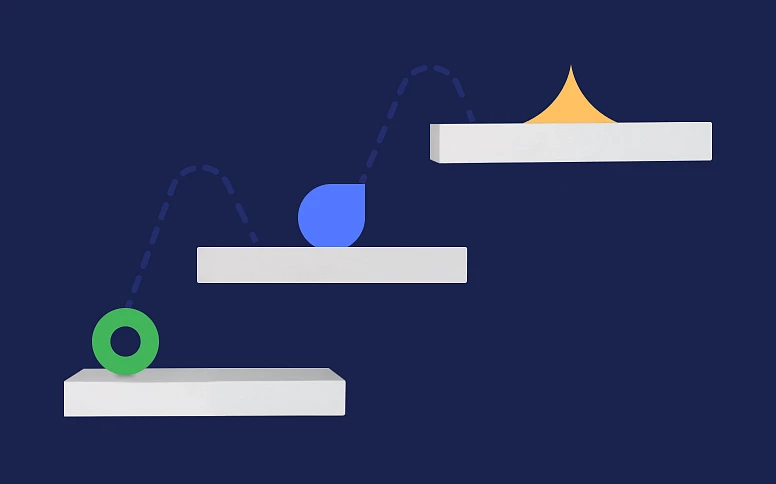Milestones: What Are They and Why Do You Need Them in Project Management?
In this article, we’ll uncover what is a milestone and why you need it to track your progress. Moreover, we’ll find out how to use it in practice and how milestones can improve your project management.
Definition of Milestones
Originally, the term milestone was used to mark the distance traveled. In project management, milestones describe the passed distance as well. Simply put, it represents activities completed during the specific phase.
However, milestones are not just a tool for simply setting stages. Milestones also help to establish activities, monitor revenues and expenses, prepare reports for the head office and stakeholders, establish deadlines and hold checkup meetings. In that case, milestones are also a powerful tool when it comes to scheduling and analysis, as you can gather metrics for a specific period.
How Milestones Differ from Other PM Components
While other activities like tasks show only small steps toward the main goal, milestones show key activities of the project. Milestones differ from goals and iterations as well.
Other project management activities are mostly related to specific actions, but milestones show the timeline. The start and end of a milestone can be related to an event, important task or deliverable. But in most cases, milestones define phases of a project.
But how to understand how milestones are different from other project management components, such as: tasks, goals and iterations? The following list will help you define the other key components of a project and how milestones are different from them.
Tasks
Even a big task is just a part of the whole stage or phase of a project. Tasks map only small steps to the main goal, while milestones are a big part of a project. Simply put, tasks define manageable parts of the project and milestones define timelines. Tasks are just included in the milestone, they have deadlines and defined steps, but the milestone helps to measure time spent and analyze activities at the end.
Goals
A goal is the main target. You can have a few of them on your project, but goals define something big. As goals represent future results, milestones show already done actions. For example, you can have a social media promotion project. During that project, you have the goal of successfully running a new course for your followers. In that case, the milestone can be reaching 50,000 followers. As you reach the milestone, you can estimate your efforts, time spent and resources required.
Iterations
Iteration is a predefined stage during the development or production of a project. After each iteration, you get a part of a product or its prototype. Iterations help to show deliverables to stakeholders or other departments. While after the iteration you get a material result (or digital if we’re speaking about software development), milestones mostly show timelines and define key events. Anyway, they can match sometimes. For example, a beta version of a project can be a milestone as well.
To sum up, milestones differ from other project management components in that they can reflect a specific period of time.
Benefits of Milestones
As it’s mentioned, milestones are powerful tools to define timelines and estimate efforts, as well as analyze and plan future strategy.
- Enhanced time management and planning
As milestones help define important events and key dates, it helps build a better structure for a project in the future. Moreover, it helps estimate the time required to complete each stage of a project. Milestones are frequently used in different project management methodologies to estimate time. For example, it’s a tool for the Critical Path Method. Milestones are also used in Gantt Charts.
- Better team collaboration
In most cases, there are lots of departments and teams involved in a project. They have to stay on deadline and plan their workflow, as well as communicate with other departments. As milestones define key activities, it’s easy to indicate if the time to ask for feedback from the other department has come.
- Finding challenges
To achieve a milestone, you should perform predefined tasks and activities. If you fail to meet a deadline, you can identify which tasks are stumblerocks. By monitoring milestones, you can understand what is disrupting your workflow. As all milestones are linked to each other, you can’t begin the next stage without completing the previous one, which helps you focus on current activities and get rid of disruptions from an ongoing stage.
- Regular deliverables to stakeholders
Stakeholders are interested in regular output. It’s much easier to keep them on track of the schedule and prepare reports based on milestones. It’s not necessary to report stakeholders about small and insignificant tasks, as well it’s not good to present them with just the final goal. With milestones, they can make sure the project will be completed on time and be familiar with all the key activities.
- Analysis and reports
Reports are more accurate because you can observe activities for a specific timeline and estimate how small tasks and other project components affected the milestone’s key events.. For example, in Flowlu, you can track tasks and cash flow related to the milestone. It’s handy not only for reporting, but also for planning future projects.
How to Set Milestones
Milestones can be added to any type of project. Anyway, their number and key events depend on the type of project, its industry, the size of the team and other dependencies.
Originally, there are five average milestones:
- Initiation
- Planning
- Implementation
- Monitoring
- Closure
If necessary, you can change and add new milestones to your project, but in most cases, this list is appropriate for all projects.
To set milestones, you have to understand your key dates and activities. It’s important to remember that milestones are closely related to meetings with investors and stakeholders, as you need to run them after each phase is completed.
To smoothly track progress but not overload a project with multiple milestones to complete, it’s important not to add just a few milestones, because it’ll prevent you from estimating the progress correctly. Otherwise, when there are too many milestones, you can just get confused and confuse your stakeholders as well. Map only the key activities of your project based on important events or deliverables.
Since all the milestones are established, the project manager is responsible for running regular meetings with both stakeholders and the project team. As milestones are based on key events, they also have to be mentioned on project’s documentation.
Examples of Milestones in Projects
As it was previously stated, project milestones are mostly related to key events, meetings with stakeholders or significant outputs.
Consequently, we can define the following milestones as examples:
- Project approval
- Start and end dates of any stage
- Critical or significant tasks with a huge effect on the final output
- Meetings with stakeholders
- Team assembling
- Design approval
- Reaching the goal
- Financial management
- A product prototype or a new module
The results of all the milestones should be reflected in reports for stakeholders. It will not only help ensure that the workflow goes smoothly, but it will also help you track productivity.
To Sum Up
Milestones help you achieve the final goal of a project step by step. If all the milestones are properly established and help you follow the right path. Anyway, they’re just one tool in a whole arsenal of project management tricks, but they’ll help you be prepared for unexpected situations and avoid mistakes.
To run a project successfully, you also have to follow specific PM methodologies, manage stakeholders, and enhance communication with the team.
Project milestones are significant points or events within a project's timeline that denote an achievement or a phase of work that has been completed. They are used to track progress and highlight key moments in the project's lifecycle.
Milestones are identified by analyzing the project's scope and breaking down the work into key components. Events such as the completion of a major phase, critical tasks, or achieving specific objectives can be considered milestones.
Milestones are important because they provide a clear indication of progress, help to align team efforts, facilitate stakeholder communication, and can be used as checkpoints for evaluating the project's health and direction.
Milestones represent significant achievements or phases and do not involve direct actions, while tasks are the specific actions or work items that need to be completed to reach a milestone. Milestones serve as markers of progress, whereas tasks are the steps taken to achieve that progress.











